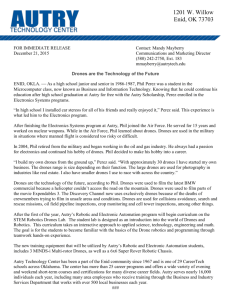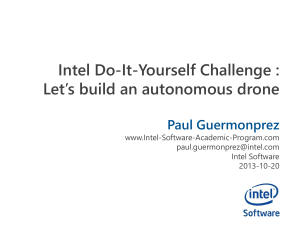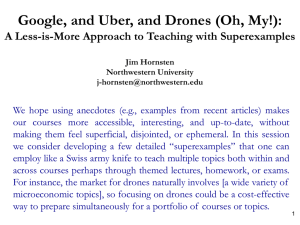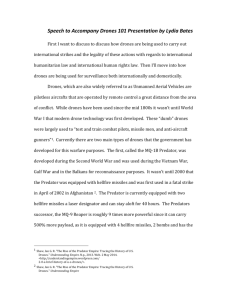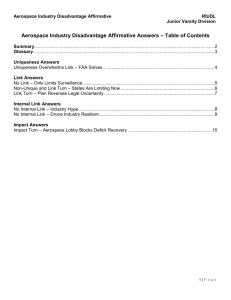karma
advertisement
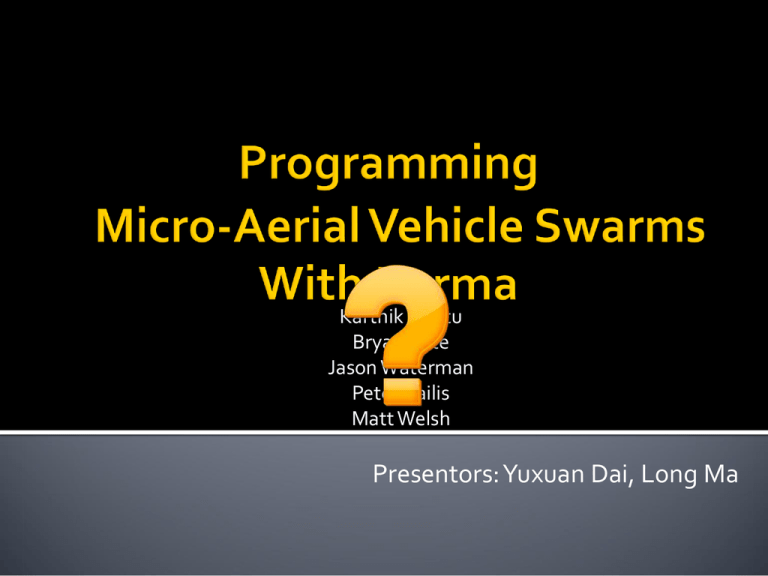
Karthik Dantu Bryan Kate Jason Waterman Peter Bailis Matt Welsh Presentors: Yuxuan Dai, Long Ma Advantages Extremely small Large number Can be applied to enclosed, close-quarter areas deployed to achieve a task massively Can perform tasks that challenging for larger platforms Provide robustness to failure in the field weight buget Restrictions actuation sensor and others Limited resources power buget Complex coordination actuation cumputating and sensing swarm size Simplify MAVs’ behavior uniformly Combine MAV behaviors with a swarm-level goal Eliminate low-level MAV coordination from users programming hive-drone model model drones cannot communicate with each other (X, Y) drones operate without precise knowledge of location Introduction Hive-Drone Model Karma Implementation Evaluation Our Thoughts Coordination complexity Programmer cannot explicitly coordinate MAV’s behavior drones cannot communicate with each other 1.Simiply MAV programming Introduce a information 2.Better decision delay in the making system Sortie Disease! Behavior Application Disease! Spatial Decomposition 1. Make it easier to reason about MAV allocation. 2. It is unlikely that the MAVs can access to high-resolution location services in the field 3. Using a Cartesian coordinate system is not necessary T,R,N T,R,N Data Model The hive maintains a key-value repository called the Datastore. Updates to this data structure are The Datastore can be queried both asynchronous, occurring when temporally and spatially drones return from a sortie Programming Model Every behavior produces some type of information under normal execution 1. Activation Predicate 2. Progress Function Scheduling Problem 1. Use the shortest time to Complete application Drone 1 run behaviors A in R1 (t1) Drone 4 run behaviors A in R3 (t4) Advocate scheduling all The hive-drone, programming model transform the available drones greedily problem of executing an application on a MAV swarm into a problem of scheduling behaviors on drones. Drone 2 run Drone 3 run System executes behaviors are behaviors B inthat R6 behaviors A in R7 concurrently activated in sequence (t2) (t3) If behavior A and B are activated concurrently (greedily schedule all available drones) Interleaves allocations for A and B Schedule all drones for A then for B No distinction Drone N run behaviors Drone 1 run A in Rx behaviors A in R1 (tn) (t1) Drone 1 run behaviors B in R1 (t2) Drone n run behaviors B in Rx (tn) Scheduling Problem 1. Use the shortest time to Complete application 2. Achieve fairness between behaviors Minimize the difference in progress between any two activated behaviors Introduction Hive-Drone Model Karma Implementation Evaluation Our Thoughts Karma Controller Scheduler Karma Implementation Dispatcher Datastore Process Total Workload Remaining Workload Service Level Allocated Drones A 100 80 0.8 40 B 100 20 0.2 10 Process: a. Estimate the total workload b. Allocate the available drones fairly basing the remaining amount of work. Process: a. Help drove transmit the data to hive Datastore b. Charge the droves c. Notify the Controller of the resource availability Two kinds of Dispatch policies: a. Continuous dispatch policy Provide a constant presence of drones in the field Minimize the information latency b. Greedy dispatch policy Dispatch the drones opportunistically Introduction Hive-Drone Model Karma Implementation Evaluation Our Thoughts Evaluate the effectiveness from three aspects: Execution time Energy cost Information latency Karma: a. greedy dispatching b. continuous dispatching Oracle: with foreknowledge of all activities, hence it can give a lower bound of requirements. Resilience to Failure fail-->cannot update Datastore-->Dispatcher detects that-->Scheduler re-arranges in next allocation cycle. Can be mitigated by reserving drones or increasing the swarm size. Adaptability introduce a constant wind over the bottom third of the field. In that field, the round trip time reduces 32% For same amount of work, 12% more drones. Equally, 7% higher energy cost Interesting feature: static VS active Hive-drone paradigm can be used to continuously measure time varying phenomena Example: a chemical plume tracking application Active Sliding window T:5m Static The current system is limited by the flight time of drones. If the drones had a longer flight time, they can operate different tasks per sortie which makes the system more efficient. The assumption in the design is that the drones cannot communicate with each other. If the communication could be achieved, the allocation policy might be changed and information latency might also be reduced. Inspired by idea of communication between two drones, communication between two hives may improve the coverage of application.





